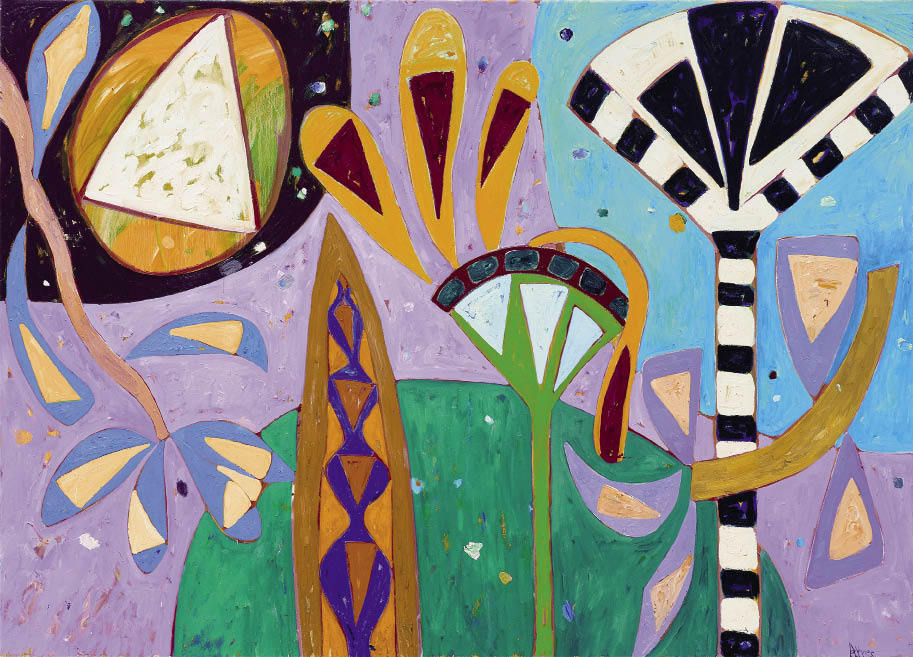The Summer Exhibition
Royal Academy of Arts, until 22 August
The Weston Room is packed with prints as usual, but also features five display cases of artists’ books, including work by such masters of the genre as Ron King, Ken Campbell and Ian Tyson. Among the prints I particularly liked Bronwen Sleigh’s hand-coloured etching, Terry New’s digital print, Cornelia Parker’s etched worry lines, the screenprints of Stephen Chambers, Eileen Cooper’s linocuts, Ivor Abrahams’s ‘Suburban Totem’ and etchings by Paula Rego, Frank Auerbach, John Carter, Peter Freeth and Eileen Hogan (a pale beauty of Bryanston Square). The Small Weston Room is a typical feast of tiny paintings, and supremely popular with the buying public. Here are such old favourites as Diana Armfield and Bernard Dunstan, both 90 this year and still going strong, and a trio of Elizabeth Blackadder still-lifes. Several larger paintings, such as Derek Balmer’s autumn birchwood and Mick Rooney’s bewitched food-oriented tableaux, help to make sense of this room. Among the smaller works I spotted through the crowds: Alf Stockham’s ‘House and Boats, Dingle Peninsula’, Frank Tinsley’s ‘Tug, Portishead’ and ‘Manchuria’ by Gus Cummins.
Gallery III is sparely hung and all the more effective for it. The prestigious end wall is given over to Gillian Ayres this year, whose five glorious paintings lift the heart with their unabashed decorative vigour and add unremittingly to the sum of human happiness. By rights, she should have won the £25,000 Wollaston Award for the most distinguished work in the exhibition, but no doubt Yinka Shonibare’s ‘Crash Willy’ accorded more with the judges’ fashionable directions. To the left of Ayres hang a couple of John Wragg’s tough figurative acrylics, to the right six gouache portraits by Humphrey Ocean. Quite a display. Elsewhere in this room there are three gorgeous oils by Stephen Chambers, a refreshingly thought-provoking abstract by Henry Mundy, all gold discs and tesserae, and an intriguing Mick Moon called ‘Tree’. Gallery IV has been hung by Fiona Rae with invited artists who mostly failed to move me, though the two small oils by Cecily Brown were the best by her I’ve seen recently, particularly ‘Don’t Wake Me Up’.
Sculpture dominates Gallery V, hung by Ann Christopher, whose own drawings feature here strongly. Drawing is a theme: the nudes by Anthony Caro may surprise some people, but the lovely big gouache and charcoal by Nigel Hall can only serve to emphasise the stature of this artist. Hall’s elegant cast bronzes reinforce this impression: time for a museum show of his work in London. Meanwhile a group of three compact cast aluminium forms by Geoffrey Clarke remind us how good this rather neglected sculptor can be. In Gallery VI, two big pastel, watercolour and gold leaf designs for mosaics in Westminster Cathedral by Leonard McComb act as lunettes to St Anthony (surrounded by fish) and St Francis (by birds). A group of witty paintings by Adrian Berg mostly offer transcriptions from Indian fabrics. A vast Anselm Kiefer looks like baked mud tricked out in pastel hues.
More sculpture in Gallery VII: a gorilla made of wire coathangers by David Mach, a group of pastels and reliefs by Ken Draper, most beguiling when he moves further into three dimensions (more, please), some lithe and lively cut-outs by Ivor Abrahams. Tess Jaray’s exquisitely judged patterns and colours contrast effectively with Michael Sandle’s dark and disturbing watercolours, and his martial ‘Night & Day’ diptych in lead-like fibreglass. Among other things, Gallery VIII contains a minimal Roy Oxlade painting of Hamlet and a lime-green bat by Rose Wylie, a lovely Leonard Rosoman drawing, robust yet delicate, and a couple of blue painted roundels by Dhruva Mistry. Gallery IX is landscape-themed, from a bright Phil Sutton to a loose, expressive Simon Carter and some ineloquent Hockney photocollages. A powerful corner filled with Tony Eyton’s recent Australian paintings scarcely prepares the exhausted visitor for the wonders of a Lecture Room beautifully installed with architectural models and drawings, which deserve a review to themselves.
The Central Hall is memorable for work by Eileen Cooper, Allen Jones, Phillip King and a little ‘Oak’ by Liam Hanley. In Gallery X, some of the best things are skied or grounded, such as Clyde Hopkins’s luminous ‘Elective Affinities’ and Colin Self’s etchings of dead birds in tribute to Craigie Aitchison, inspired by hearing that Aitchison painted a dead bird to bring himself luck. (These, incidentally, were printed by Maurice Payne, whose lacklustre portrait by David Hockney appears in Gallery III.) There are too many mediocre photos in this room, excepting Allen Jones’s ‘Undressed Hatstand’, though a harrowing Bill Viola video adds tone. At the exit, Quentin Blake’s giclée prints of brush drawings lighten the mood.
As you are leaving, don’t overlook the tributes to Academicians who have died in the past 12 months. These are displayed in the John Madejski Fine Rooms this year — a bad move not only because they’re isolated from the main body of the show, but also because the Fine Rooms close at 4 p.m. Two of my old friends are celebrated here, so to my mind it would be a tragedy if people miss them. In the first room, a couple of bronzes by Barry Flanagan complement the delicate geometricised landscapes of Flavia Irwin. In the central room, John Craxton and Craigie Aitchison are celebrated: Craxton in fine style, with early work from the 1940s and the superb 2003 ‘Cretan Cats’, a mini-retrospective; Aitchison disappointingly, with no really substantial work, though the ‘Pink Crucifixion’ etching gives a flavour of what we’ve lost. In the far room, Freddie Gore is remembered with a couple of splendid 1950s landscapes and more recent work; Michael Kidner by a group of coloured pencil molecular structures; Donald Hamilton Fraser by his distinctive dark landscapes. Long may their art bring joy.






Comments